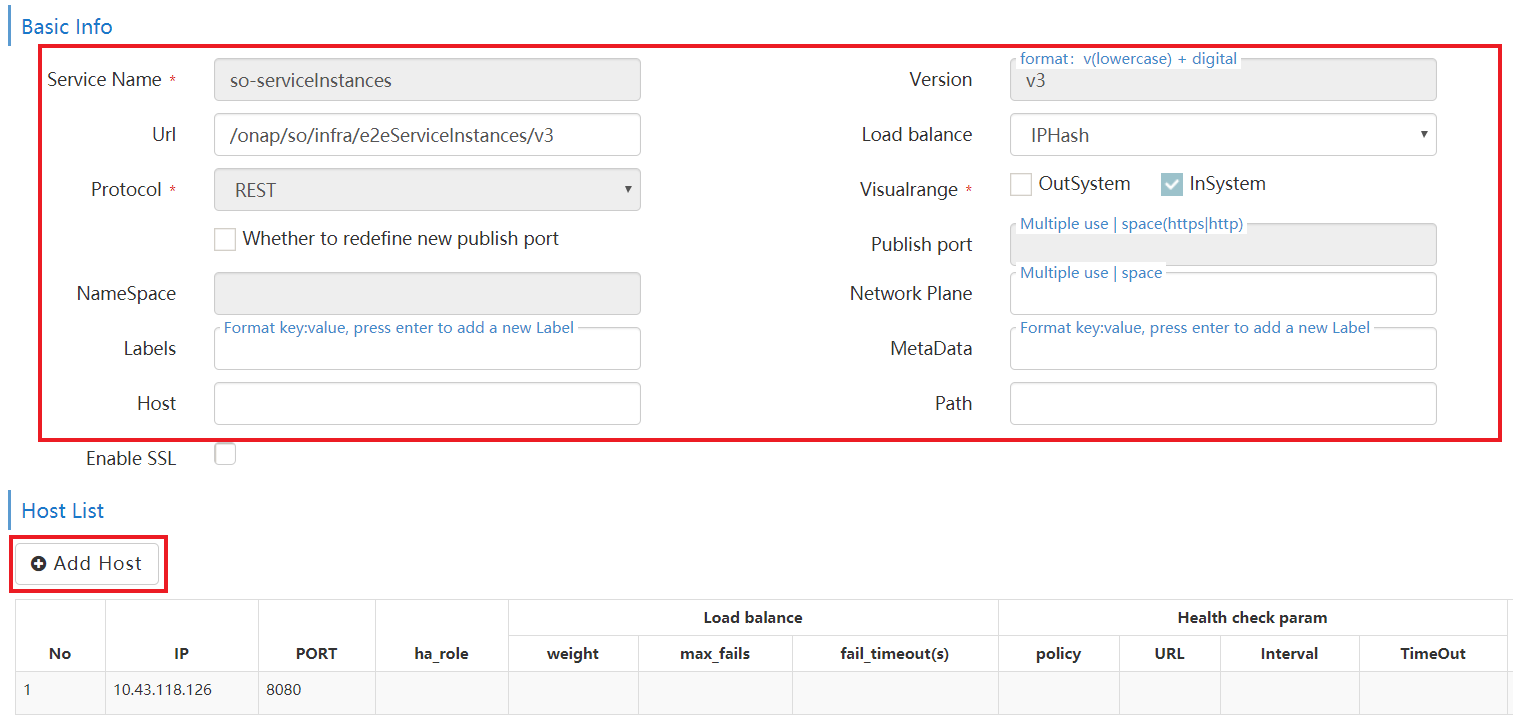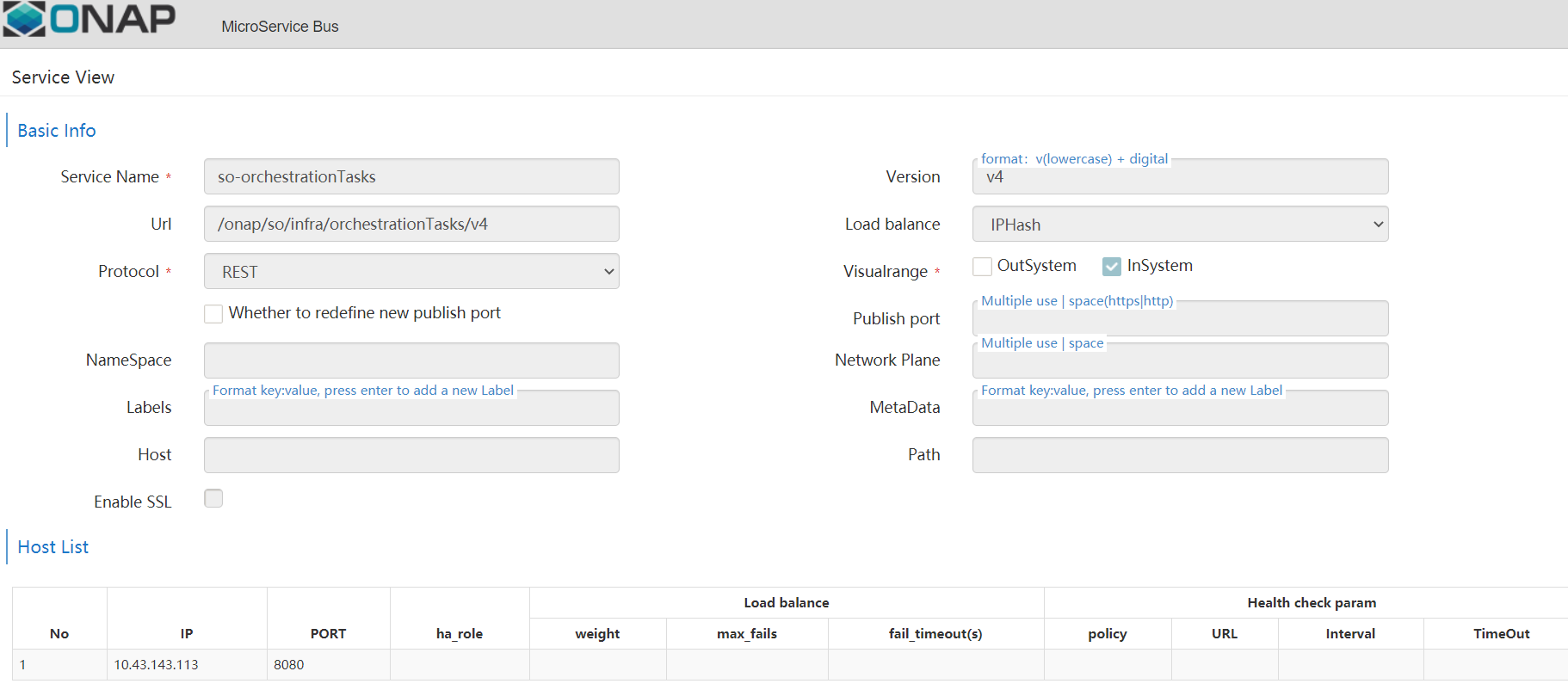This page explains the manual configurations required for setting up E2E network slicing use case - option 1.
1. SDC
ONAP Portal: https://portal.api.simpledemo.onap.org:30225/ONAPPORTAL/login.htm (Username:cs0008, Password:demo123456!)
SDC UUI: https://sdc.api.fe.simpledemo.onap.org:30207/sdc1/portal#!/dashboard
Refer for Template Design for Option 1 respective template creation and distribution.
2.UUI Configuration
Configure CST template UUID and Invariant UUID in slicing.properties file of uui-server microservice
In uui-server microservice, modify the following configuration file, /home/UUI/config/slicing.properties
Add or update the parameters slicing.serviceInvariantUuid and parameter slicing.serviceUuid.
The values of these two parameters come from CST template which can be find on SDC page.
3.MSB Configuration
Register so-orchestrationTasks and so-serviceInstances interface to MSB.
Interface registration can be done through portal.
Steps(Portal):
Link: https://{{master server ip}}:30284/iui/microservices/default.html
1.Select ‘’ in the left pane
2. Click 'Service Register' button.
3. Input the basic info as the picture shows(also refer to the registration info provided above)
4. Click Add Host button.
Input IP Address and Port then click the 'SAVE' button. (Use cmd ’kubectl get svc -n onap so‘ to confirm IP and port.)
6. You should add a aai-business service for MSB.
Steps:
- Got to msb https://{{master server ip}}:30284/iui/microservices/default.html
- Select "Service Discover" from left panel
- Click "Service Register" button
- ADD the following info:
Service Name: aai-business
Url: /aai/v13/business
Protocol: REST
Enable SSL to True
Version: v13
Load balancer: round-robin
Visualranfe: InSystem - Add host:
AAI service ip and port (8443)
- ADD the following info:
- Save all
4. SO
Copy subnetCapability.json to SO-API Handler pod to configure subnet capabilities at run time.
You can copy the file to the pod using the following command
|
SO Database Update
Insert ORCHESTRATION_URI into service_recipe, SERVICE_MODEL_UUID replaced by CST.ModelId.
|
Insert ORCHESTRATION_URI into service_recipe, SERVICE_MODEL_UUID is ServiceProfile.ModelId
|
5.OOF Configuration
OSDF CHANGES(FOR NST SELECTION) for Guilin Release
New NST templates can be added in. There is a json file present in the osdf folder, where the nst templates can be added with the corresponding ModelId and ModelInvariantUUID.
The json file is found in the osdf folder in the corresponding path
apps/nst/optimizers/conf/configIinputs.json
6. Policy Creation Steps
Refer Optimization Policy Creation Steps for optimization policy creation and deployment steps
Copy the policy files
unzip policies.zip |
Refer Policy Models and Sample policies - NSI selection for sample policies
Updated slice/service profile mapping - https://gerrit.onap.org/r/gitweb?p=optf/osdf.git;a=blob;f=config/slicing_config.yaml;h=179f54a6df150a62afdd72938c2f33d9ae1bd202;hb=HEAD
NOTE:
- The service name given for creating the policy must match with the service name in the request
- The scope fields in the policies should match with the value in the resourceSharingLevel(non-shared/shared). Do modify the policy accordingly.
- Check the case of the attributes with the OOF request with the attribute map (camel to snake and snake to camel) in config/slicing_config.yaml, if any mismatch found modify the attribute map accordingly.
You need to restart the OOF docker container once you updated the slicing_config.yaml, you can do it using the following steps,
- Login to the worker VM where the OOF container is running. You can find the worker node by running (kubectl get pods -n onap -o wide | grep dev-oof)
- Find the container using docker ps | grep optf-osdf
- Restart the container using docker restart <container id>
7.AAI Configuration
Create customer id :
curl --user AAI:AAI -X PUT -H "X-FromAppId:AAI" -H "X-TransactionId:get_aai_subscr" -H "Accept:application/json" -H "Content-Type:application/json" -k -d '{
"global-customer-id":"5GCustomer",
"subscriber-name":"5GCustomer",
"subscriber-type":"INFRA"
}' "https://<worker-vm-ip>:30233/aai/v21/business/customers/customer/5GCustomer"
Create service type:
curl --user AAI:AAI -X PUT -H "X-FromAppId:AAI" -H "X-TransactionId:get_aai_subscr" -H "Accept:application/json" -H "Content-Type:application/json" -k https://<worker-vm-ip>:30233/aai/v21/business/customers/customer/5GCustomer/service-subscriptions/service-subscription/5G
8.ConfigDB
Config DB is a spring boot application that works with mariaDB. DB schema details are available at Config DB.
Install config DB application in a separate VM. MariaDB container should be up and running to access the config DB APIs.
Refer https://wiki.onap.org/display/DW/Config+DB+setup for configDB setup. Latest source is available at Image versions, preparation steps and useful info-Config DB Preload Info Section.
Necessary RAN network functions data are preloaded in config DB while booting the maria DB container.
Note: Refer the latest templates from gerrit which are committed in June 2021. https://gerrit.onap.org/r/gitweb?p=ccsdk/distribution.git;a=commit;h=8b86f34f6ea29728e31c4f6799009e8562ef3b6f
9. SDNC
Install SDNC using OOM charts and the below pods should be running. As ran-slice RPCs are not visible in the latest SDN-C image, use the image version 2.1.0 for sdnc-image and dmaap listener. Manually, load the RANSlice DGs like below:
- Copy the DG XMLs from /distribution/platform-logic/ran-slice-api/src/main/xml (gerrit repo) to /opt/onap/sdnc/svclogic/graphs/ranSliceapi(sdnc container)
- Install the DGs : a) Navigate to /opt/onap/sdnc/svclogic/bin (Sdnc container) (b) Run ./install.sh
SDNC Pods
|
Check the below in SDNC pod (dev-sdnc-0).
- Latest ran-slice-api-dg.properties (/distribution/odlsli/src/main/properties/ran-slice-api-dg.properties) should be available at /opt/onap/ccsdk/data/properties/
- All ranSlice*.json template files (/distribution/platform-logic/restapi-templates/src/main/json) should present at /opt/onap/ccsdk/restapi/templates/
- DG XML files from /distribution/platform-logic/ran-slice-api/src/main/xml should present at /opt/onap/sdnc/svclogic/graphs/ranSliceapi
- Go to /opt/onap/sdnc/svclogic/bin
Run ./install.sh << this should re-install and activate all DG's>>
Note:
If SDN-C deletion is unsuccessful due to the leftover residues, use the below commands to delete it completely.
DMAAP Messages
Refer SDN-R_impacts for Dmaaps messages that can be used as an SDN-R input for RAN slice instantiation, modification, activation, deactivation and termination.
ACTN Simulator:
This Simulator section is bypassed and a workaround is used to continue the flow. Workaround is done in the SDNC DG. <>
ranSliceApi not deployed into SDNC
This issue occurs because you need to set the env SDNR_NORTHBOUND=true for the sdnc-image. This is by default set to false. With this flag all sdnr-northbound features are installed during startup.
How to fix it?
- Setting env into SDNC HELM CHART
- Go to values.yaml of SDNC OOM folder : https://gerrit.onap.org/r/gitweb?p=oom.git;a=blob;f=kubernetes/sdnc/values.yaml;h=fc093b8637bd64aaa523b9d0c2295fb6542a2a7d;hb=refs/heads/honolulu#l217
Add param sdnrenabled: true , under config section, like below:
config: sdnrenabled: true odlUid: 100 odlGid: 101
- Setting env into SDNC HELM CHART
- Rebuild the SDNC package and redeploy it.







2 Comments
Elangovan Thanasekaran
Hi Ahila P ,
We are trying to validate the communication between NSSMF adapter→ TN NSSMF → SDNC. Do we need to setup ACTN simulator for validating this flow.
Currently in the step 9 of E2E network slicing Option 1 – New E2E slice, in the AN NSSMF to SDNR for front TN slicing, we are getting below error.
<output>
<response-message>Error executing UNI coloring for domain B</response-message>
<ack-final-indicator>Y</ack-final-indicator>
<svc-request-id>e06b4128-7f12-445e-bf8b-811f6ef189b5-1632719288066</svc-request-id>
<response-code>500</response-code>
</output>
Can you please provide information on DG builder is used for bypassing ACTN simulator for SDN controller, which DG is used for that.
Also let us know if you have any further information on this error.
Regards,
Elangovan T
Deepika S
Hi Elangovan,
To skip SDNC workflow for the Transport domain, pl follow: SO-3444 - Getting issue details... STATUS